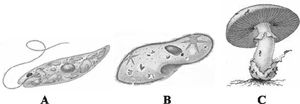Biological Classification MCQ Question with Answer
Biological Classification MCQ with detailed explanation for interview, entrance and competitive exams. Explanation are given for understanding.
Download Biological Classification MCQ Question Answer PDF
Question No : 15
Identify the following figures A, B and C. 
A – Euglena, B – Paramecium, C – Agaricus
A – Euglena, B – Planaria, C – Agaricus
A – Planaria, B – Paramecium, C – Agaricus
A – Euglena, B – Paramecium, C – Aspergillus
Question No : 16
Choose the correct names of the different bacteria given below according to their shapes. 
A – Cocci, B – Bacilli, C – Spirilla, D – Vibrio
A – Bacilli, B – Cocci, C – Spirilla, D – Vibrio
A – Spirilla, B – Bacilli, C – Cocci, D – Vibrio
A – Spirilla, B – Vibrio, C – Cocci, D – Bacilli
Question No : 17
Refer the given figure of bacteria cell and Nostoc and choose the option which shows correct label for the structure marked as A, B, C, D and E ? 
A – Cell wall, B – Cell membrane, C – Heterocyst, D – DNA, E – Mucilagenous sheath
A – Cell wall, B – Cell membrane, C – DNA, D – Heterocyst, E – Mucilagenous sheath
A – Mucilagenous sheath, B – Cell membrane, C – DNA, D – Heterocyst, E – Cell wall
A – Cell membrane, B – Cell wall, C – DNA, D – Heterocyst, E – Mucilagenous sheath
Question No : 18
Select the correct match from the given option.
Occurrence of dikaryotic stage - ascomycetes and basidiomycetes.
Saprophytes - They are autotrophic and absorb soluble organic matter from dead substrates.
Vegetative mean of reproduction in fungi - fragmentation, budding and sporangiophores.
Steps involved in asexual cycle of fungi - plasmogamy, karyogamy and meiosis in zygote resulting in haploid spores.
Question No : 19
Match the characters given in column I with their examples given in column II.
| Column I | Column II |
|---|---|
| A. Long slender thread | (i) Lichen like structures |
| B. Association of fungi with | (ii) Mycorrhiza roots of higher plants |
| C. Parasitic fungi on mustard | (iii) Neurospora |
| D. Fungi extensively used in | (iv) Albugo biochemical and genetic work |
| E. An association in which | (v) Hyphae algal component is called phycobiont |
A-(v) B-(ii) C-(iv) D-(iii) E-(i)
A-(iii) B-(i) C-(iv) D-(ii) E-(v)
A-(ii) B-(i) C-(iii) D-(v) E-(iv)
A-(iii) B-(ii) C-(iv) D-(i) E-(v)
Question No : 20
Which of the following groups of protozoan is not correctly matched with its feature?
Amoeboid - Marine forms have silica shells on their surface.
Flagellated - Either free living or parasitic.
Ciliated - Actively moving organisms due to presence of cilia.
Sporozoans - Move and capture their prey with the help of false feet.
Question No : 21
Match column I with column II and choose the correct option.
| Column I | Column II |
|---|---|
| A. Mycoplasma | (i) Nitrogen fixing cells |
| B. Decomposers | (ii) Blue green algae |
| C. Methanogens | (iii) Production of methane |
| D. Heterocysts | (iv) Most abundant heterotrophs |
| E. Cyanobacteria | (v) Pathogenic in plants and animals |
A-(i) B-(ii) C-(iii) D-(iv) E-(v)
A-(iii) B-(v) C-(ii) D-(iv) E-(i)
A-(iii) B-(i) C-(v) D-(ii) E-(iv)
A-(v) B-(iv) C-(iii) D-(i) E-(ii)